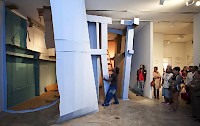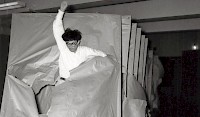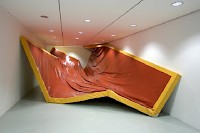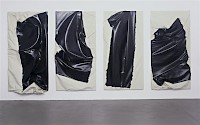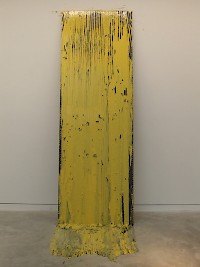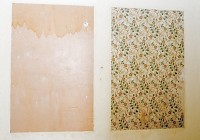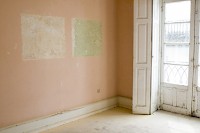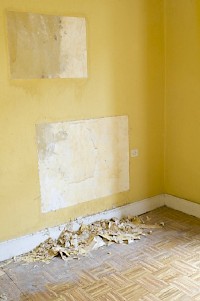A certain uncanniness is transmitted by any act of destruction of art. Some forms, or ways, of creating a damaged or “destroyed” painting not only modify, but also mutate representation from something affirmative into a territory that dislocates meaning and becomes performative. The destruction of painting is a wide field worth investigation, and by crossing into art history reveals aspects that the academic perspective often overlooks. In the practice of some contemporary artists the act itself of destroying painting can be seen as a form of abstracting the content of painting by minimizing its narrative load and reflecting on the subjacent void that exists in any built form. Destroying or dismantling existing layers of paint as a form of systematic vandalism has been conducted in recent practices as an investigation of the processes of creation and value attribution.
The paradigmatic work Passage was performed in 1955 in Tokyo by Saburo Murakami, one of the members of the Japanese avant-garde action group, Gutai, whose experiments foreshadowed (much earlier than the Euro-American avant-garde) the essence of Happenings, Nouveau-Realism, Abstractionism, and Conceptualism. For Gutai, interested in the materiality and force of elements, action is a way of painting with the elements. Murakami, who jumped through a row of canvases in his performance—tearing them completely apart in the process—practises painting as a form of spirituality not far from animism through immersion into matter and the natural processes of decomposition. Painting, for Murakami, is a way to awaken matter just as perforating his own canvases is a way of awakening painting. This excerpt from Gutai’s manifesto addresses its new vision of performativity: “Under the cloak of an intellectual aim, the materials have been completely murdered and can no longer speak to us. Lock these corpses into their tombs. Gutai art does not change the material but brings it to life. Gutai art does not falsify the material.”1
The jump into nothing has a long history in contemporary art and can be read as a somewhat fatal drive for nonsense or negation in artistic terms. In the case of Murakami, the artist’s jump into the paintings annuls the finality, the justification, and the consequences of his own artistic acts. At the same time suicidal, provocative, social, and philosophical, Murakami’s act is also a statement of preservation by freezing a sacrificial moment of loss that ultimately leads to transformation and renewal, thereby becoming a mode to integrate one’s art into a historical flow.
The shock and rupture in the continuity of representation and the interruption of narration and narrative potential that this act of destruction brings, seems to be a condition of the modern aesthetic experience. This broken continuity, which Walter Benjamin connects to the apparition of film, also means the beginning of a critical, political experience of art. The first symptoms of this new awareness see Benjamin connected with the art of Dada, followed by the segmented images that film brought with it, and which he situates in opposition to the painting in modern times. Decades later the painting itself came to incorporate this broken identity.
“From an alluring appearance or persuasive structure of sound the work of art of the Dadaists became an instrument of ballistics. It hit the spectator like a bullet, it happened to him, thus acquiring a tactile quality. It promoted a demand for the film, the distracting element of which is also primarily tactile, being based on changes of place and focus that periodically assail the spectator. . . .The spectator’s process of association in view of these images is indeed interrupted by their constant, sudden change. This constitutes the shock effect of the film, which, like all shocks, should be cushioned by heightened presence of mind (italics mine).” 2
The event itself, based on this shock and abrupt break, or rupture, has played a tremendous role in recent theory, especially regarding our perception of time and space. Following Benjamin, the event is a consequence of technology, and its representational effects cut, stop, and then again release space and time. This ahistoricity, indetermination, and discontinuity produce an object of art that is not only contingent, but also performative. It is an object that is a result of representation but also creates its own reality and brings it actively into manifestation.
In this light, a destroyed painting is more than a painting on which an intervention has been performed and more than a hybrid. It is a new media, which determines the viewer’s participation and brings into being the instruments through which the painting can be perceived and conceptualized. It transforms the bi-dimensional surface of painting into a tri-dimensional object while at the same time incorporating its documentation. A destroyed painting is one that carries the marks of the actions performed upon it.
The young Portuguese artist Carlos Bunga engages in the destruction, or partial destruction, of paintings based on an extended vision of painting itself. Painting is, for him, an architecture of colour, superimposed layers that form the constructed space of colour. In his performative architectural constructions he builds walls out of fields of colour, but also exhibits landscapes of pigment that represent, for him, the decomposition of the act and the result of painting itself. Here, the result of a performative act carries within itself the documentation of the destruction of the initial painting.
Much like the actions of Murakami in an early performance work, Paintings, Bunga perforated a painting, stepping and disappearing into the space of the actual painting. Bunga’s main aim is to determine a set of transformations in the pictorial space and shake up the pre-supposed spatial continuity by breaking its identity and destroying its narrative load. In his practice, a destroyed painting becomes a document of the instability of space and of the transformations that it experiences. By staging “accidents,” and through the process of voluntary demolition, he is introducing into painting a contra-rhythmical time frame and various overlapping temporalities as forms of investigating space and time, not according to what remains visible, but according to the yet unmanifested potentialities they carry. He is documenting, not specific events, but the potential of painting to carry this trauma of visuality that is intrinsic to all contemporary forms of representation. The viewer himself is slipping into an ambivalent position: he is included in the event of the work, but he is, at the same time, a critical observer and witness.3
In the curatorial text that accompanies the exhibition Iconoclash (2002, ZKM Karlsruhe) Dario Gamboni4 follows—in science, religion, and art—the phenomenon of disputes around image worship (iconodulia) versus image phobia (iconoclastia) and the vandalism that these conflicts brought to the history of culture. For Gamboni, any representation of the destruction of an image is not only a documented act, but more importantly, a reflection on the meaning of damaging or destroying a work which has been identified as a product of a particular culture whether a public monument, a painting, or a religious icon. Gamboni writes that throughout the history of art, the representation of destruction of a painting by overpainting has usually been regarded as vandalism, since, from the perspective of the public domain and the desire to protect cultural heritage, the destruction of a cultural product will inevitably be understood as irrational and barbaric.
In all acts of destruction of a finished piece there is a subtle movement between the long and arduous process of building a culture and the momentary action: the impulse to destroy these emblems and with them everything they symbolize. Through the process of destruction the images themselves become mobile. A single image is context dependent and proves its intrinsic multiplicity while still able to serve a plurality of discourses (for example iconodulistic and iconoclastic) at the same time.
The long history of destroying paintings is aligned with progress rather than annihilation: cultural heritage is destroyed to make room for a new ideal. Destruction, understood as appropriation, was the weapon that the neo-avant-gardes used against the classical avant-gardes. In 1953 Robert Rauschenberg erased a drawing of the Expressionist Willem de Kooning. Now in the collection of the San Francisco Museum of Modern Art, Erased de Kooning Drawing is considered the first neo-conceptual gesture.
In Steven Parrino’s art,5 vandalized painting is also a response to a fetishistic approach to painting itself. Directed against the supremacy and self-sufficiency of the monochromes, his acts consist of removing his own paintings from their frames, destroying them, and then reintroducing them, with folds and fissures, back into the frame. Alexis Harding, who started working a decade later, allows the actual pigment to slide out of the frame and “disappear” into the exterior space. Angela de la Cruz destroys paintings to a point where they lose their pictorial expression and become broken, useless objects in space.
These works respond not only to the quality of painting itself, but also to an academically and hierarchically oriented educational system (one based on the supremacy of masters and their skills) that new generations need to adopt and transmit within a teacher-master relationship. Action, as a suicidal performance of the artist, is therefore a way of introducing movement into an educational system that would otherwise suffocate its younger breed.
Other artists react against the perfection of their own painting: Noel Dolla throws doses of colour over his paintings after completing them; Pascal Pinaud, one of his students, draws over, scratches, and lacerates his paintings. The materiality and the processes of intervention therefore come into the foreground of representation, bringing into disequilibrium the iconicity of monochromes. Brian Müller explains6 that a destroyed painting is also one that is not looked upon as a precious object on the wall but which lies on the ground and is viewed from above.
Throughout the history of art, these processes have consistently demonstrated that the destruction of art is itself another form of art. Appropriation of an image or an existing work through an intentional action is a form of creating art as a protest without any compensation or even justification: it is an extreme artistic manifesto. These radical gestures are, at the same time, ways of refusing to bring anything to the new, empty place that they themselves have created. These empty places and the rejection of substitution is the highest form of protest.
